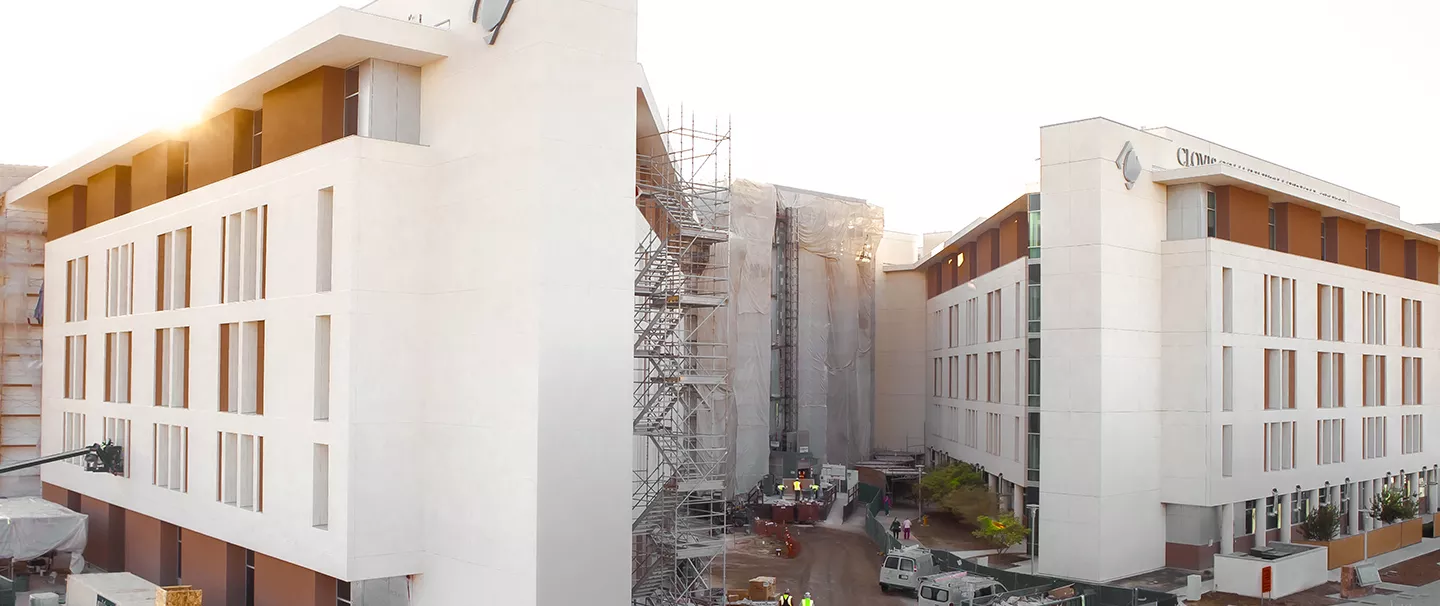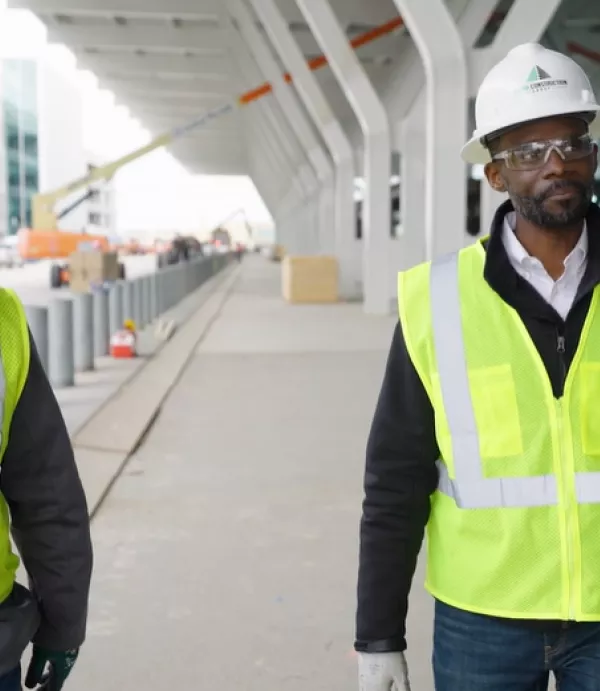Five Keys to Advancing Critical Healthcare Construction During a Global Pandemic
July 15, 2021

Unprecedented partnership and planning drive construction efforts at Clovis Community Medical Center forward, enabling medical center to support critical community needs amidst the Covid-19 pandemic.
Structural steel assembly is now complete on a new entrance to the Clovis Community Medical Center, ushering in new era for the regional health system. This signature architectural element is one of several significant construction milestones achieved by Clark Construction and Clovis Community’s facilities planning and construction department over the past year as part of the hospital’s Phase C expansion. Amidst one of the most devastating global health crises of the last century, Clark and Clovis Community teams have safely advanced the $430 million project, furthering the hospital’s long-term goals for added capacity while simultaneously supporting life-saving operations as the Covid-19 pandemic surged and pushed the facility to its limits.
An essential piece of the healthcare infrastructure, Clovis Community serves residents throughout California’s Central San Joaquin Valley. Clark has worked hand-in-hand with Community Medical Centers to support the expansion and modernization of its facilities in the region for nearly two decades. The Phase C project marks the team’s fifth collaboration on the Clovis campus and includes the construction of a new five-story patient tower, as well as an expansion to the hospital’s emergency department, pharmacy and laboratory, materials management, loading dock, and dining and nutrition services. A new lobby building and 617-space parking structure are also included in the scope.
The four-year expansion and renovation project was nearing the half-way point when the pandemic first took hold. Amidst a state-wide shelter-in-place order, Clark and Clovis Community determined how to move construction forward while safeguarding patients, hospital staff, and construction crews. As Covid-19 cases rose steadily during the fall months, the Central Valley was among hardest hit regions in the state. Community Medical Centers’ two acute care hospitals cared for more COVID-19 patients than all of San Francisco County’s hospitals combined. Despite the dynamic and complex challenges of building in and around an active Covid-19 treatment facility, the construction team pressed on. Their persistence drove much-needed work forward, but more importantly, it enabled them to provide vital support to the hospital during the pandemic’s unrelenting second wave.
“Clark has served as a trusted partner to Community Medical Centers for nearly two decades. Our ability to navigate the events of the last year and support the rapidly evolving needs of this community, would not have been possible without the trust and teamwork that exists between our two organizations. We are incredibly grateful for Clark’s partnership and for the perseverance of our trade partners who helped us move this project forward under extraordinary circumstances.” - Craig Wagoner, executive vice president & chief operating officer, Community Medical Centers
As Covid infection rates diminish and the country begins to reopen, Clark and Clovis Community leaders reflect back on the challenges and triumphs of an unprecedented year, and five keys to keeping this essential project on track during the pandemic.
- Ensuring Safety was a Shared Priority
As a stay-at-home edict went into effect in spring 2020, Clark worked closely with Clovis Community leaders, construction trade partners, and Cal-OSHA representatives, to chart a plan to safely continue construction while minimizing the risk of virus spread.
The hospital’s ever-changing set of circumstances demanded intensive communication between construction and hospital officials. To choreograph operations in and around active Covid-19 treatment areas, the team coordinated with myriad hospital departments. They also studied the hospital’s Covid-19 patient routes and treatment areas to identify opportunities to create greater separation between construction crews and patients.
“Every day things were changing, every day we were learning more and more about how the pandemic was affecting the hospital and where they were going to put Covid patients,” said Tyson Johnson, Clovis Community’s manager of facilities planning and construction.
Clark implemented robust Covid-19 management protocols, which included conducting health screenings for craftworkers each morning before they entered the jobsite. Clovis Community also screened individuals at each entry point of the existing hospital. As an added safety measure, the partners also established on-site Covid testing for construction workers, as needed, which was supported by the hospital’s lab.
As demand increased for PPE nationwide, trade contractors struggled to secure face coverings for their workforce and grappled with the added costs of safety. Aware of the challenges crews faced, hospital leaders stepped in to provide support, ensuring that craftworkers had the safety equipment necessary to feel comfortable coming to work.
The pandemic wasn’t the only crisis in the Central Valley that threatened construction efforts and worker safety. Wildfires in the area in late summer through early fall also created hazardous conditions for crews working outdoors. Poor air quality spurred new OSHA stipulations, requiring craftworkers to wear N-95 masks to work. Again, the hospital provided the necessary PPE to keep crews working safely and keep the project on track.
“Safety was a shared priority for our teams,” added Jon Dearinger, Clark’s vice president in charge of field operations on the Phase C project. “The support we received from the hospital was essential to us remaining safe and to making our construction crews felt it was safe to come to work.”
- Accelerating Work to Provide Value and Critical Support for the Medical Campus
As the second wave of the pandemic surged throughout the Central Valley in late 2020, its ripple effects were felt across the Clovis Community campus. In December, the hospital’s Respiratory Department reported that they were at 80 percent capacity with oxygen levels. “We typically refill the oxygen tanks once a week during flu season, and once every two weeks during normal operations,” noted Alex Torres, Clovis Community’s director of facilities planning, construction and plant maintenance. “In December, we were refilling the tank every other day.”
As hospital leaders looked across California, they witnessed several health facilities in a critical state. It was only a matter of time before Clovis would be in a similar situation if they didn’t act quickly.
Clark’s scope on the Phase C project included an expanded bulk oxygen yard, but that work wasn’t slated to be complete until February 2021 – two months away. With Clovis Community’s ICU nearing capacity, and surge bed conversions increasing, the demand for oxygen was outpacing the hospital’s regular output. Anticipating an after-Christmas surge, the Clark and Clovis Community teams worked to re-sequence and accelerate construction of the bulk oxygen yard to meet the urgent need. With time of the essence, Clark and its trade partners committed to completing two months’ worth of work in just one week.
Clovis Community team and Clark led two-a-day meetings with trade partners’ leadership to map the timeline of events leading up to the new oxygen yard installation, developing an hour-by-hour schedule for crews to follow. During the operation, crews worked around the clock to execute the complicated scope. The most critical component of their operation included shutting down the hospital’s existing oxygen source for seven hours while crews tied in the new system. To keep the gas flowing to patients during the shutdown, the team back fed oxygen to the hospital from four locations using a 3,400-gallon trailer and 200 H type cylinders.
Working through the night, the team switched over to a new capacity oxygen tank just before Christmas Eve, increasing the hospital’s oxygen capacity four fold. They completed the operation without impacting air pressure and patient care within the hospital. The State’s regulatory agency, OSHPD, signed off on the new oxygen system in record time later that same day.
“Clark was instrumental in bringing on our new bulk oxygen system online two months ahead of schedule. We completed that work in one week with lots of help from our trade partners,” stated Johnson.
- Bringing key trades to the table to ensure trust, transparency, and team alignment
Every day the pandemic presented a new set of variables for the hospital and construction team to contend with. Successfully navigating the fluid conditions required that everyone be in lock step. To foster an open dialogue and ensure alignment among key stakeholders, Clark instituted weekly meetings with Clovis Community and the lead project manager and superintendent from each major trade. The Wednesday sessions gave everyone a seat at the table and served as a platform to discuss changes in hospital operations, construction sequencing, and safety protocols; they also provided a platform for trade contractors to raise issues and concerns about schedule and workforce changes, work conditions, and other hot topics that, if not addressed in a timely manner, could have festered and caused disruptions to the job.
The meetings created an open line of communication among hospital leaders, Clark, and key trades, which allowed problem-solving to occur in real time, helped progress inspections, and streamlined decision making. With the mechanical/plumbing, framing/drywall, and electrical trade leaders who participated in the discussions representing 70 percent of the construction workforce, gaining consensus within this leadership group meant quick alignment among the larger construction team.
The meetings also forged trust among the project team and gave Clark and trade contractors the confidence to not only continue work, but to grow the workforce on site by nearly 300% over the ensuing months.
- Proactively Engaging Regulatory Agency OSHPD to Gain Expedited Approval for Critical Elements of Work
California’s Office of Statewide Health Planning and Development (OSHPD) monitors the construction, renovation, and seismic safety of health facilities. OSHPD’s approval is a critical factor in a healthcare project’s success and can be an intensive process. Through their extensive experience working with the regulatory agency, Clovis Community and Clark leaders knew that fast-tracking the OSPHD inspection and approvals process would be the linchpin to executing any emergency operations on the hospital campus.
The typical OSHPD sign-off period for work associated with an oxygen yard is close to a month. As the team developed plans to accelerate this element of work just before the Christmas holiday, an imperative piece of the puzzle was getting early buy-in and support from OSHPD officials. Clovis Community contacted OSHPD’s Area Compliance Officer, who has jurisdiction over the Clovis project, to convey the gravity of the situation. Through those early conversations, OSHPD pledged to expedite the operation on the new tank, which would increase the hospital’s oxygen capacity by four times.
Through extensive coordination among Clark, key trade partners, OSHPD, and hospital personnel, the oxygen tank installation was executed and certified in record time without disruptions to patient care. OSHPD officials signed off on the new oxygen system on Christmas Eve, enabling the hospital to support increased demand for the lifesaving gas throughout the holiday season and into 2021.
- Providing early access to vaccinations for the construction workforce
With work being performed in and around an active hospital, vaccines were an important safety tool to protect the patients, hospital staff, and construction crews. When vaccines became available in early 2021, Community Medical Centers deemed Clark and its trade partners as essential vendors to the hospital and provided early access to the vaccine to more than 300 construction team members in appreciation for the vital role they played in promoting the health and safety of the Central Valley community. Their support is ensuring that essential work on the Phase C project continues safely today.
In a year filled with unforeseen challenges, Clark’s and Clovis Community’s partnership brought certainty amidst uncertain circumstances, enabling much needed and, at times, lifesaving work to continue, and ensuring the Clovis Community Medical Center could buoy the Central Valley community during an unprecedented time. When complete in 2022, Clovis Community’s new entrance and patient tower expansion will usher in a new era for the community hospital – one that better positions the facility to support community needs, including another global health crisis, well into the future.


